The Origins of Loy Krathong
According to Thai folklore, the Loy Krathong Festival originated in Sukhothai. Established in 1238, the ancient kingdom of Sukhothai was a thriving, prosperous region. Local legend says that at some time in the 14th century a noble lady called Nang Noppamas, a consort of the King of Sukhothai, made the first decorated krathong as a gift. The daughter of a Brahmin priest, Noppamas adapted an existing Brahmin tradition by delicately molding banana leaves into the shape of a lotus flower before adding a candle and incense sticks. The story goes on to say that the king lit the candle and the incense sticks and floated the krathong on one of the waterways surrounding Sukhothai.
Sukhothai, the kingdom’s ancient capital, officially kicked off Loy Krathong Light and Candles Festival amid the eyes of thousands of local and foreign visitors. The province became the first venue to start the Loy Krathong festivities featuring the lighting of dainty flower-shaped floats, candles, and fireworks lighting the night sky of Sukhothai Historical Park.






Join our trip Nov 2023, click Special Loy Krathong Festival
Sukhothai, the kingdom’s ancient capital, officially kicked off Loy Krathong Light and Candles Festival amid the eyes of thousands of local and foreign visitors. The province became the first venue to start the Loy Krathong festivities featuring the lighting of dainty flower-shaped floats, candles, and fireworks lighting the night sky of Sukhothai Historical Park.
The Loy Krathong Festival started after the governor of Sukhothai rang the traditional bell that resonated within the ancient historical park. The celebration started in the day and involved colorful parades of floats in various designs and sizes of the traditional Loy Krathong usually in the shape of fanciful and colorful lotus flowers. All nine districts within the province have sent in their contribution to the parade with their interpretation of the Krathong or floats which emphasized environmental-friendly materials to make the floats. The parade marched past Wat Channa Songkram temple within the historical park while visitors and tourists alike watched the beautiful floats pass them in awe. It also included a procession of historical traditions and culture, a representation of Sukhothai life which flourished in the 13th and 14th centuries and where many historians believe the tradition of Loy Krathong was first celebrated. Grand performances were also conducted at night, including traditional Thai music, Khon or masked dance performances, and the Noppakao Pagent contest. Folk dancing that depicts the traditional Sukhothai life is also held.


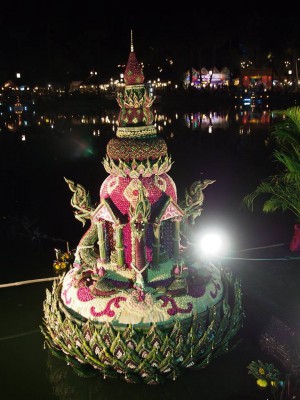
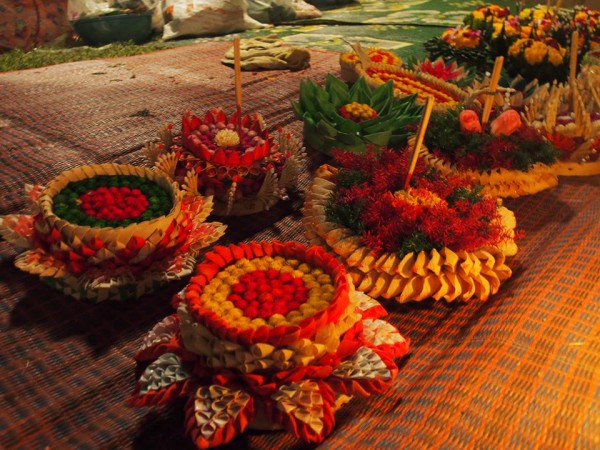
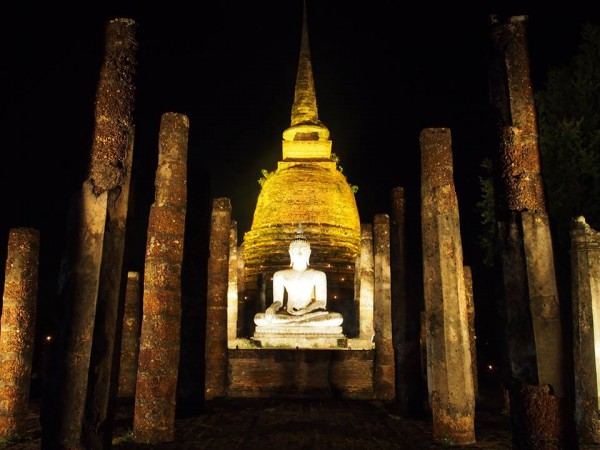

Join our trip Nov 2023, click Special Loy Krathong Festival
Choose your Krathong
Some of the most beautiful Krathong are made from all-natural materials such as banana leaves, the bark of a tree, and flowers just as they would have been made when the tradition first started. Modern-day Loy Krathong sees a mix of Krathong being made including some which use the dreaded styrofoam. In Sukhothai, the waterways are enclosed and any Krathong which aren’t bio-degradable can be fished out and disposed of without causing any significant damage to the water and wildlife. Sadly, that isn’t the case in other areas of Thailand although trends are changing for the better as people become more environmentally aware. In recent years there has been an encouraging move towards using traditional, natural Krathong, and fish-friendly bread Krathong in the shape of turtles has also proved popular.
Join our trip Nov 2023, click Special Loy Krathong Festival
THING TO DO IN SUKHOTHAI:-
Sukhothai is full of Historical sites that reflect the glorious civilization of the former capital that remains for future generations to carry on preservation. Visitors can discover the grandeur of the Sukhothai Kingdom within the World Heritage-listed Archaeological sites like the Sukhothai Historical Park which is home to palaces and ancient religious sites with moats and ancient City walls surrounded. See the beauty of Phra Achana or the Speaking Buddha at Wat Si Chum, which is enshrined in the Mondop with only four walls remaining, resulting in a strange and magical image. Pay respects to Wat Mahathat which has a stupa-shaped pagoda which is a unique art of the Sukhothai kingdom as well as other important temples of the province such as Wat Phra Prang and Wat Chang Lom. In addition to ancient sites, Sukhothai province also has interesting tourist activities. Being close to nature and Lanna civilization at Thung Saliam District. Be amazed by the chinaware which is a valuable handcraft Culture that has been passed down for a long time in Si Satchanalai.
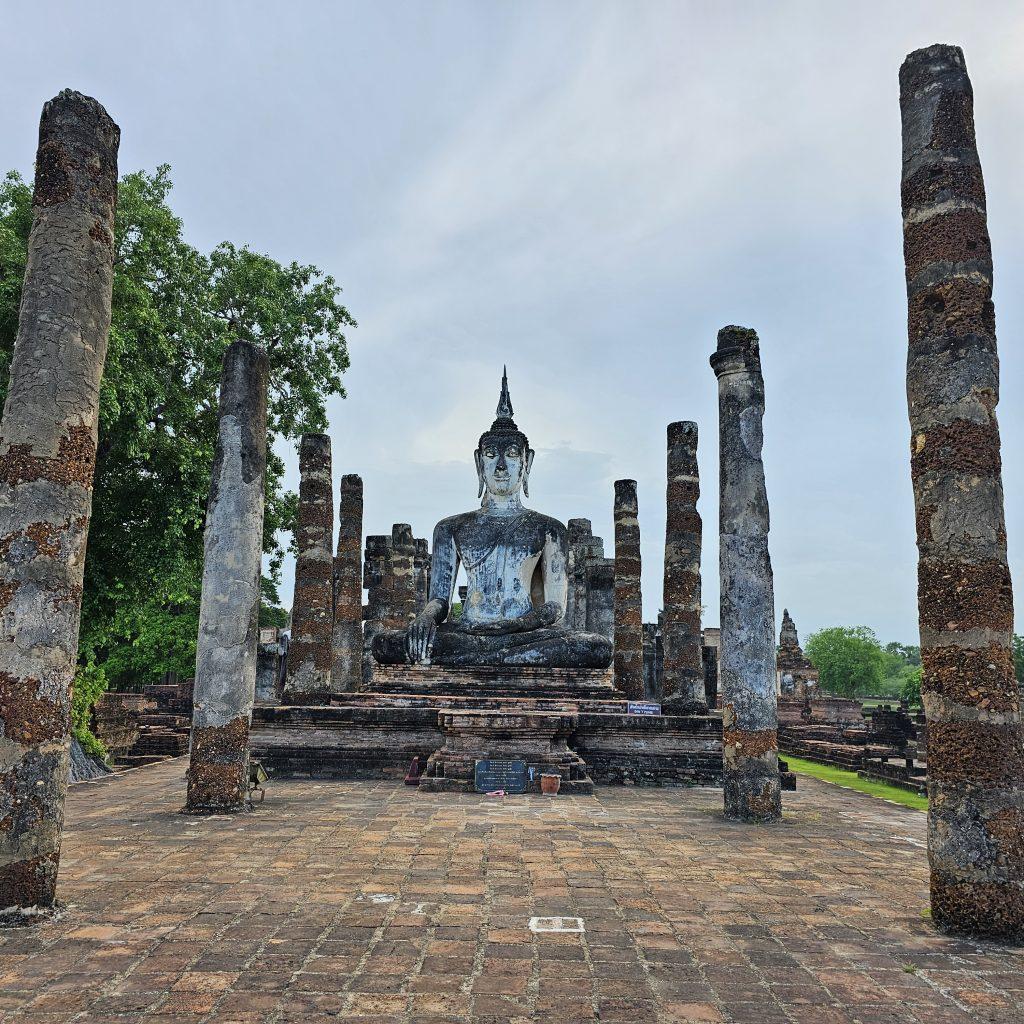





Join our trip Nov 2023, click Special Loy Krathong Festival
Sukhothai is the very first capital city of Thailand. In the golden time of this city, it is the center of everything in this south-east Asia. Now a day the ruin from that glorious time is left behind for people of this generation to study stories about one of the ancient cities that accept by the United Nations Educational Scientific and Cultural Organization (UNESCO) to be World Heritage. Sukhothai Historical Park locations are the opposite of Ramkhamhaeng National Museum. There are a lot of interesting places inside this area. Wat Maha That. This temple is the center of the historical park. Inside the temple is the grand pagoda that surrounds by another 8 pagodas as if they are lotus. The front gate of the temple has a Buddha statue called Phra Atha Ros.



The King Ramkhamhaeng monument. This monument can be found at the end of Jarod Vitee Tong Road on the north side of Wat Maha That.
Join our trip Nov 2023, click Special Loy Krathong Festival
Sukhothai City’s defensive wall. It is a two-layer wall that uses to defend the city. The inner layer is built on the upper ground and uses laterite as a material. The outer layer is a canal switch with a slit wall. Between two layers there city gate and a defensive fort on both sides of the defensive wall. Wat Chana Songkram. This temple locates on the north side of Wat Maha That. The point of interest is the main pagoda inside the temple that looks like a giant bell. Prasart Phra Ruang hill. This area use to be a royal palace located on the east side of Wat Maha That. Wat Tra Phang Ngearn. This temple locates on the west side of Wat Maha That. The temple has no wall and only one lotus-style pagoda inside. Wat Sa Sri. This temple locates on the northwest side of Wat Maha That. The design of this temple is actually outstanding from other temples around it has a building on a pool and a pagoda in Ceylon style.
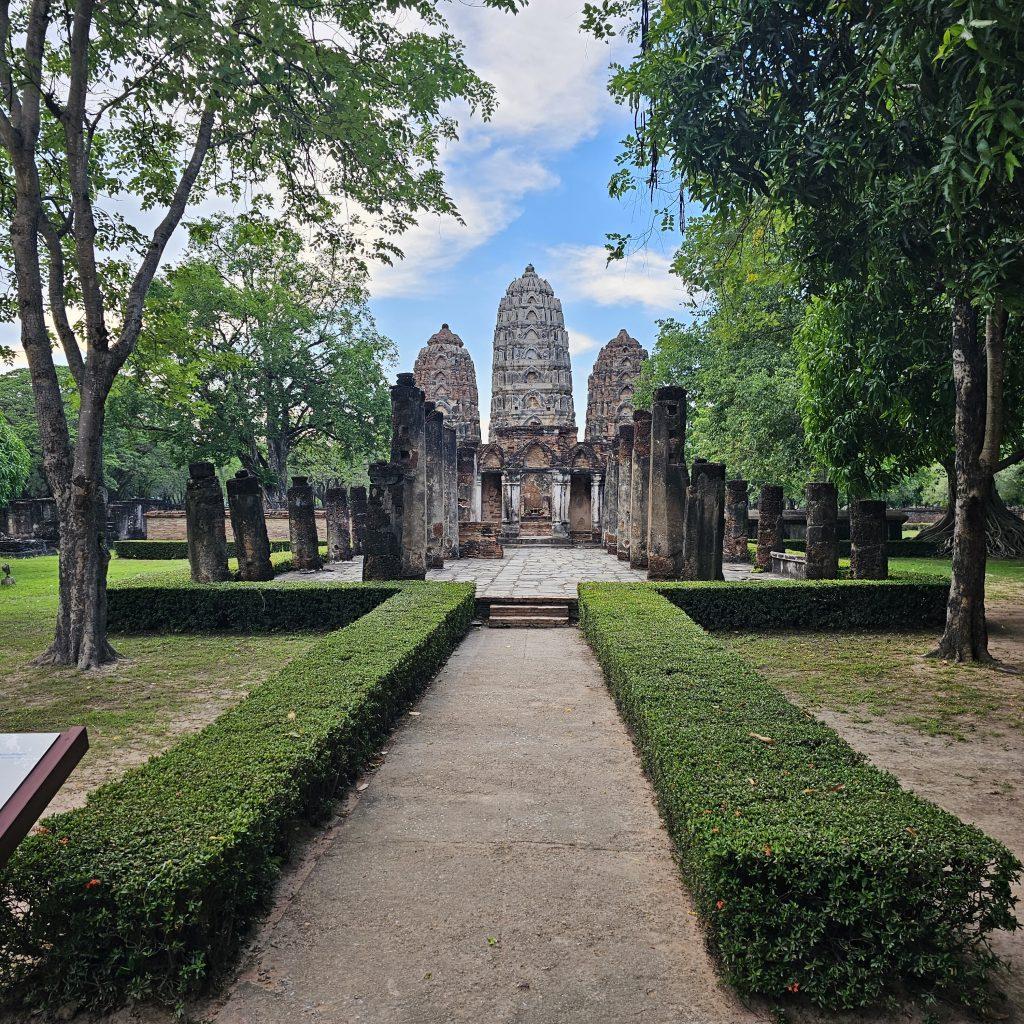


Join our trip Nov 2023, click Special Loy Krathong Festival
Wat Sri Swai, this temple locates on the south side of Wat Maha That. There are three pagodas built in Lopburi style inside the temple. Ta Pha Deang Shrine. This ancient shrine that builds in Khmer style. Fine Arts Department rebuilt this shrine and bought the relics they found inside to Ramkhamhaeng National Museum. Wat Phra Luang Luang is the second most important temple after Wat Maha That. This temple is the center of the community back in its time. The oldest remains of the temple are the three pagodas. Sukhothai Historical Park Tourist Center. This center is a Thai-style Sukhothai architecture. Located in front of Wat Phra Phai Luang. Inside the center, there is information about Sukhothai Historical Park to provide for tourists. Sukhothai pottery archaeological site. This site is near Wat Phra Phai Luang around the old moat area called “Mae Joan”. The burner historian found here is a burner from the Sukhothai period. Pottery that is mostly found in this area is cups and bowls. Wat Sri Chum. This temple has a large Buddha statue called Phra Ajchana. Due to the old condition of the temple, there is barely anything left to see this temple in the shape of the building however the statue is still in task and remains until this day. Wat Charng Rob. This temple is located on the west side of Reed Gate. There are pagodas in Ceylon style which have to surround abase by 24 elephants. Sreed Phong Dam. This dam locates in the old city district. The purpose was to build this dam to store water and then send it through a canal around the city’s defensive wall to the gold and silver basin inside the city. Wat Che Tu Phon. The temple has a sanctuary built from brick, laterite, and slate. Inside the sanctuary, there are four statues of Buddha in different poses including sit pose, lay down pose, stand pose, and walk pose. Wat Jedi Si Hong. This temple is located on the east side of Wat Che Tu Phon. Inside the temple has a Ceylon pagoda that decorates with man and woman sculptures around the base of this pagoda. Wat Sapan Hin. This temple standing Buddha image in attitude of meditation tall around 12.5 m. called Phra Attha Ros. Wat Chang Lom. This temple has a Ceylon pagoda that decorates with half elephant sculpture around its base. Wat Tra Pung Thong Lang. This temple is located at the end of Jarod Vitee Tong. Inside the temple has a sanctuary and a Buddha statue that tells the story of when Buddha came back to earth and edify his own father and mother. According to the Sukhothai Travel guide, there are still some places to pay a visit. Sawan Vorra Nayok National Museum. This is another national museum aside from Ramkhamhaeng National Museum. Sri Suchanalai Historical Park. This historical park is located in Sri Suchanalai district nearby Sukhothai also this place is accepted to be a world heritage like Sukhothai Historical Park. Wat Sopharam. This temple is the present city’s temple of Sukhothai province. Mae Rawing plain. This is a beautiful public park surrounded by the waterside.
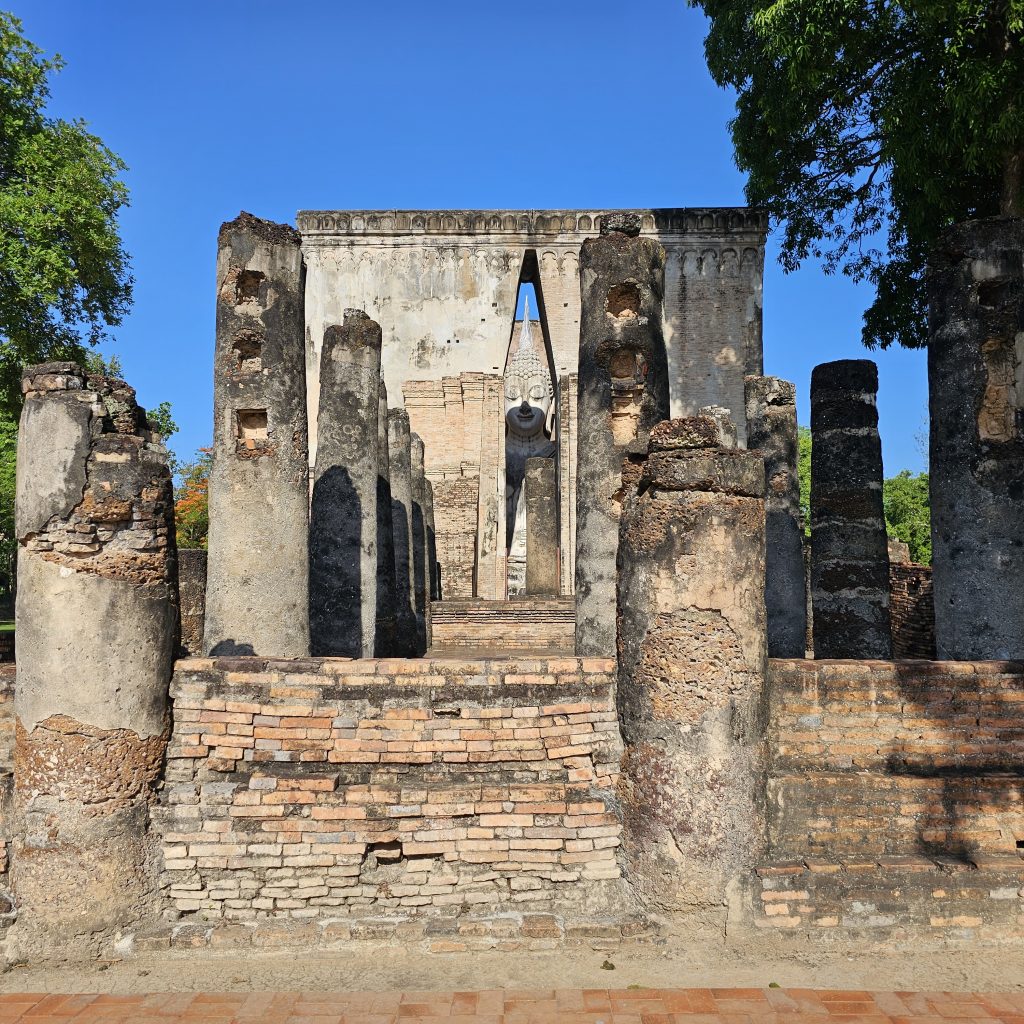
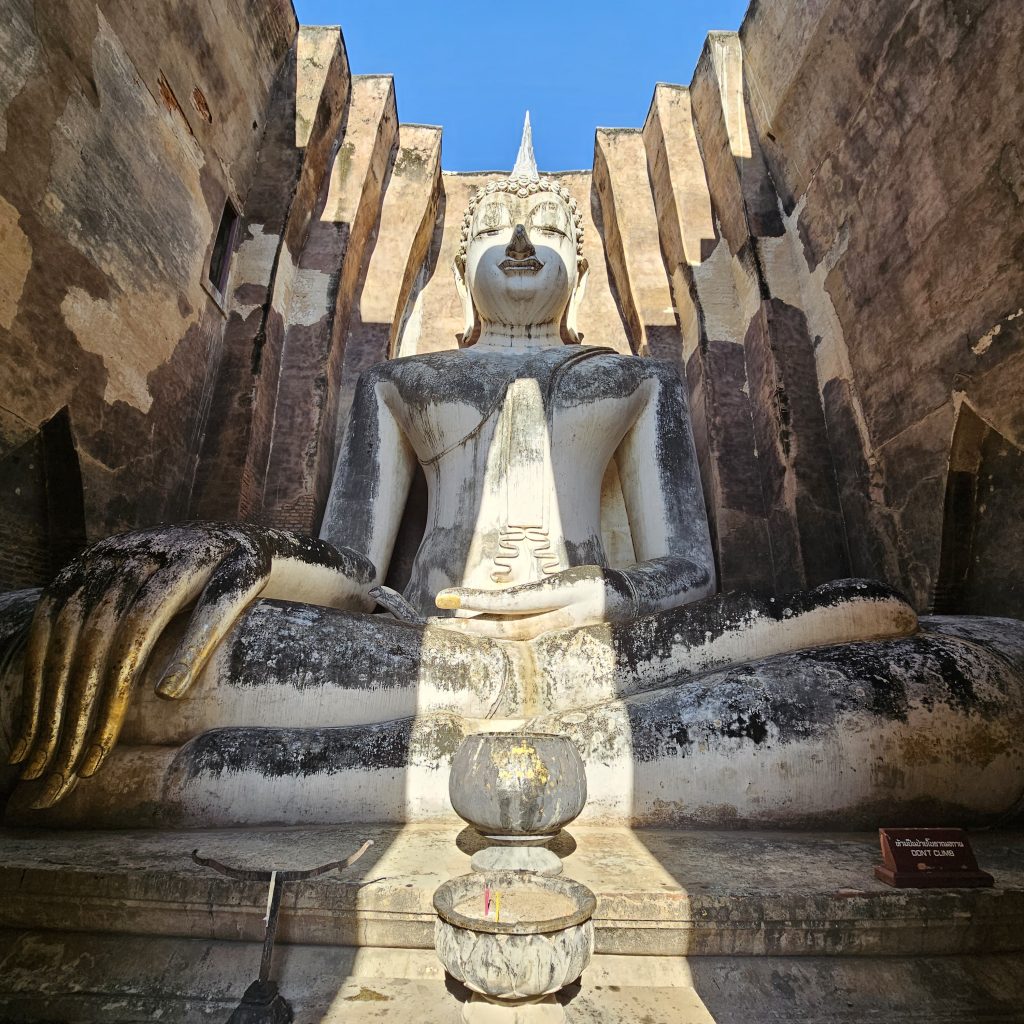
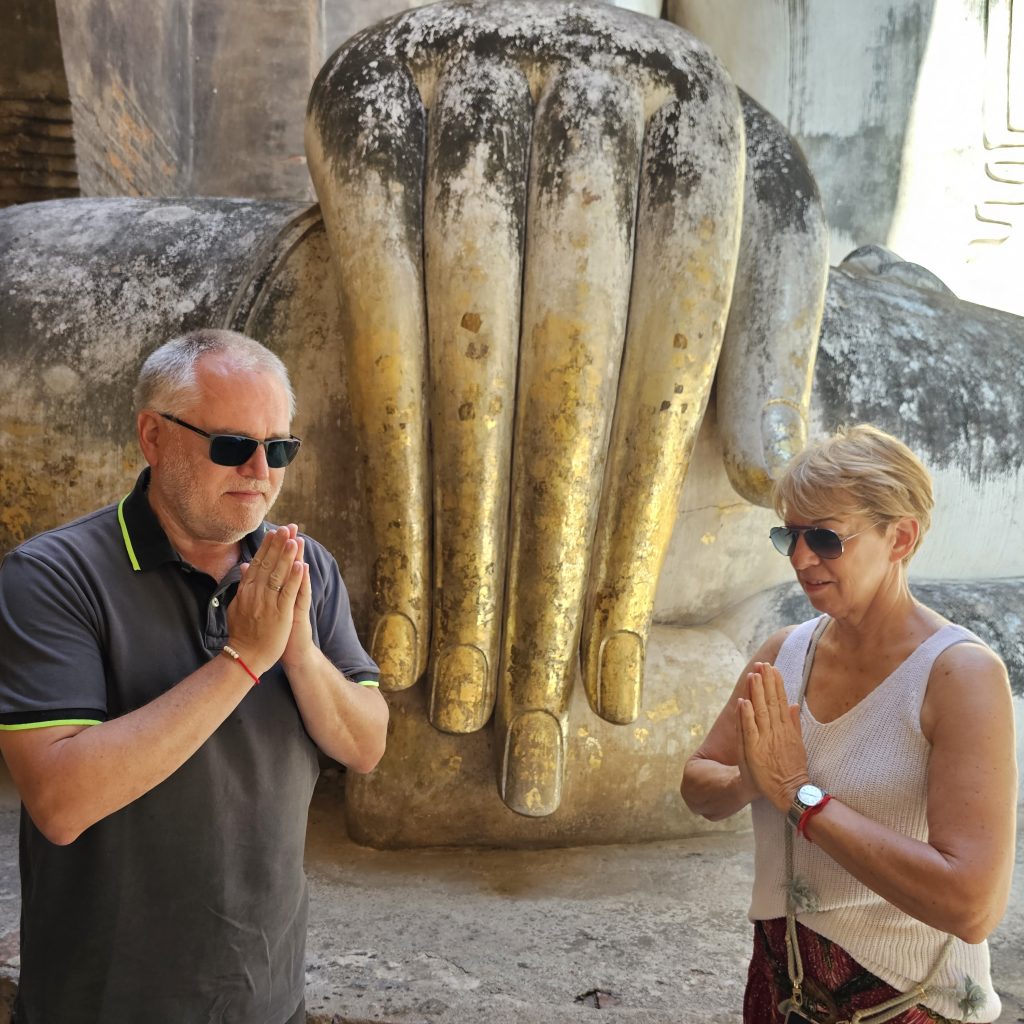
Join our trip Nov 2023, click Special Loy Krathong Festival
Wat Si Chum
Situated 800 meters west of Wat Phra Phai Luang is Wat Si Chum. A Wihan in the form of a square Mondop, which is the main sanctuary, houses a large monumental stucco Buddha image in the attitude of subduing Mara called “Phra Atchana”, which is 11.3 meters in width. “Achana” means a person who is not anxious but strong. The roof has already disintegrated, exposing just 4 walls of stuccoed bricks. There is a narrow passageway in the south wall with steps leading up to the side of the Buddha image and onto the top part of the wall. On the wall of the passageway features 700-year-old fainted paintings while on the ceiling are more than 50 engraved slate slabs illustrating Jataka scenes. A spectacular panoramic view of the Sukhothai Ancient City is visible on the rooftop accessible by the passageway. Boosting the morale of the ancient soldiers was the main reason for such mystery in Wat Si Chum. The kings of the Phra Ruang Dynasty were famous for that. One could go through the hidden passageway and address the people through a hole, making them believe the voice they were hearing was actually the Buddha’s. There are no windows here. It is believed that a vaulted roof probably covered the Wihan.
Join our trip Nov 2023, click Special Loy Krathong Festival


